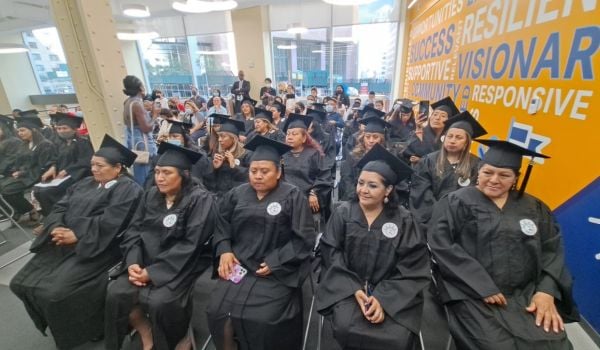Prior to the coronavirus, it might have seemed easy to imagine which jobs would remain “essential.” Doctors and nurses, certainly; grocery store workers and gas station attendants and mechanics, the type of people you meet with for what you need in good times and bad: whose work underpins our daily life, and which we could not live without.
What we may not have predicted, though, was the odd place gig work would come to hold in our labor economy during COVID-19: essential but, as always, almost invisible. Though these apps have familiar names — Uber, Instacart, Lyft, Seamless, GrubHub, Postmates — their employees, cleverly referred to as “contractors” to skirt existing labor laws, almost never communicate with their bosses or fellow contractors IRL. But as the coronavirus crisis has escalated and the ever-growing class of gig workers ascended to essential status, these “invisible” workers have, of late, proved they’re not to be overlooked. They’re demanding better and safer working conditions and fairer pay through strikes and protests. And one of the leading forces organizing those protests is a group of eleven women who’ve never met each other in person.
As the virus pushed us into our homes, the notion of ordering groceries for delivery became increasingly enticing, particularly for those already at an advanced risk of contracting COVID-19. Even before the coronavirus, the so-called gig workers for grocery and food delivery apps, among others, were already a growing sector of the workforce. According to a report conducted by the ADP Media Center and released just prior to the outbreak of coronavirus in the US, the number of laborers identifying as “gig workers” ballooned 15 percent since 2010. In that intervening decade, some additional 6 million individuals registered as gig workers — and that was before the coronavirus epidemic left 20.5 million Americans jobless.
Ultimately, though, it’s almost impossible to count how many individuals actually work as “gig workers,” a nebulous term which can encompass anything from temp workers and freelancers to Uber drivers and Instacart shoppers. Within the realm of app-based gig employment, only company executives truly know how many individuals are employed by these apps and working for them on a regular basis. And when the coronavirus pandemic began, leaving app-based food and grocery delivery people on the front lines, this built-in ambiguity tilted our ongoing inequality crisis in favor of tech companies.
When I first spoke to Susan Cuffaro, it was just a number of days after Instacart workers had announced a massive strike: the first that gig workers for the San Francisco-based company would undertake during the coronavirus pandemic. The strike, which took place March 30, had been organized by the Gig Workers Collective, a new nonprofit founded and run by eleven women located across the country.
Gig Workers Collective, the offshoot of an Facebook group for disgruntled Instacart shoppers, realized its first formal collective action in November 2019. Between 2016 and 2018, two San Francisco-based activists, Sarah Clarke and Vanessa Bain, were among many Instacart shoppers who participated in workers’ rights activism against the San Francisco-based company. The two women, living just a short distance away from each other in the Bay Area, found that they saw eye to eye on many of the same things. Though sympatico, the pair knew that they’d need some extra hands.
“A lot of times, Vanessa and I, when we get ideas, … we always wish that we had, like, a third person that we could be, like, hey, is this actually good? Does this make sense?” Clarke explains. But both wanted to make sure that their chosen group would be the right fit. Following what they called a “perpetual soft strike” in 2018, Clarke and Bain reached out to nine other women from the Instacart protest Facebook group whom they believed had stepped up into leadership roles during the rising dissent among Instacart shoppers.
“There were a lot of people I think that emerged as really organic leaders,” Bain recalls. “We wanted to organize alongside these people that had already proved themselves in a pretty large way.” .
Via Facebook messenger, the eleven women brought a new meaning to “virtual strangers:” from their homes in Ohio to Florida to California, New York, Oregon, and Nevada, they planned their first strike, set for November 2019.
At one time, the Gig Workers Collective members say, working for Instacart was a comfortable job. In 2018, the pay was good. Drivers could expect additional commissions for delivery, for each item purchased, for large orders, or for trips to stores like Costco, where items are bulky and cumbersome. Portland-based Gig Workers Collective organizer Heidi Carrico described those early days as a kind of empowerment: “For the first time, I was really contributing to my family and to paying the bills, … instead of just relying on my student loans.”
Even back then, though, Instacart had seen its share of worker dissatisfaction: in 2017, Instacart recalibrated its payment process by adding an unexplained 10 percent “service fee” to delivered orders. While customers believed at one time that the fee was going to tip Instacart shoppers, the fee was actually being funnelled to “shopper wages, customer support, and operational expenses.” The result was lose-lose: shoppers lost out on tips, while customers grew frustrated at paying extra money for unexplained costs. Eventually, the company was sued by lawyer Julie Erickson, who argued that the service fee misled customers who believed they were tipping the shoppers. Following Erickson’s pursuit, Instacart reached a settlement, agreeing to adjust its website and app to more transparently explain the opaque service fee. And that hadn’t been the first time Instacart higher-ups threatened tips for shoppers: that same year, Instacart’s drivers were frustrated by a software change that made it more difficult to receive tips.
By the close of 2018, however, frustration with the company reached a new fever pitch. After the discovery that the app had been stealing tips from delivery drivers, “it was the beginning … of a new era,” Cuffaro says, “where the amount of trust between the company and its shoppers was gone.” In November of that year, Instacart dramatically changed its payment system, going from a transparent model to what Gig Workers Collective organizers refer to as a “black-box algorithm,” a model of payment which no longer factors in distance or number of items delivered.
The 2019 strike, explained the Gig Workers Collective organizers in a statement, was “a whirlwind.” For the first time in years of public worker dissatisfaction with the company, Instacart offered indirect retaliations: first, with what the group suspects was a targeted censorship of a post on Medium, followed by removing the $3 “quality bonus” Instacart shoppers would receive after getting a five-star rating from customers. While Instacart had announced the quality bonus would be removed beginning in January of 2020, the company elected to push up the cut to November of 2019, what Gig Workers Collective members say happened “just days after our protest.” “We’re usually given concessions while something else is simultaneously taken away,” they said. “This was the first time that something has only been taken away.”
With unprecedented media attention and a central organizing group, the Gig Workers Collective’s first protest in November was a game-changer. The protests garnered media attention, and, according to the Gig Workers Collective, “caused many customers to delete the app.”
By the beginning of 2020, the group had become so active that it was seeking a new status as a non-profit in the hopes of allowing members to take on organizing full-time. Today, the Gig Workers Collective is the main mechanism through which Instacart actions are planned. The eleven members of the group, some estimated, work close to sixty hours a week each on their organizing: from IRL outreach to press outreach to moderation of the Facebook group, which has grown to more than 15,000 members since Instacart’s massive, COVID-19-related hiring surge. Additionally, Gig Workers Collective organizers are encouraged to talk to five different shoppers they see in the store while on the job, particularly when strikes are upcoming, to let them know about the Collective and any future actions.
The fifty-odd members of the Gig Workers Collective who are not the eleven core organizers are independent gig worker activists. Clarke approximates that she talks to just one of these members nearly every day, consulting on outreach, publicity, and mobilization.
For some members of the Gig Workers Collective, activism — especially workers’ rights activism — wasn’t exactly a passion before November 2019. As GWC organizer Sharon Goen explains, her mother had been a lifelong and impassioned activist. Her mother’s work had driven her away from the family, leaving her children for Washington activism when Goen was just 13 years old. “I’ve always hated politics,” Goen says, “and I really hated activism.” Still, when Clarke reached out to Goen with an invitation to collaboratively form the Gig Workers Collective, she was persuaded: “I’m honored, because I’m working with the most amazing women. Smart, conscious, brilliant, motivated, strong women. And I feel humbled to be in their group. They teach me something every day.”
Still, to be an activist in the gig work realm is an unforgiving challenge. Each of the Gig Worker Collective organizers I spoke with referenced a misconception that gig workers are “fungible” or fleeting; “drifter”-types who pass in and out of a given gig if it stops working for them. In reality, a large part of this workforce relies on gig work as full-time income, and many of these workers are nothing close to drifters: many are mothers, several are over 50.
Why don’t gig workers just quit if a given gig stops working for them? Ithaca-based Gig Workers Collective organizer Robin Pape says, “I’m a person of color. My white mother had black children in the ‘70s, and was disowned by her family. She was an advocate for equality. And I think a lot of people are, like, well, why don’t you walk away? Find a better job, it’s not a career … we recognize that things don’t get fixed like that. Vulnerable people continue to be abused.
“… Looking at the rights for minorities, or members of the LGBTQ communities, both of which still have very far to go, but if people had just walked away, or been — been unwilling to fight, or worry only about their own livelihood or bottom line, then we wouldn’t have made the progress that we’ve made as a country. I mean, even just the whole labor economy, and having weekends off and limited work hours and — and paid time off and sick leave, these are things that nobody would enjoy if, instead of fighting back, people just walked away when they were unsatisfied. And so I think, for most of us, that’s why we stay, and we continue to fight.”
When the COVID-19 pandemic hit its apex in the U.S., members of the Gig Workers Collective worked fast. By late March, coronavirus cases skyrocketed. “We were learning of more and more people getting sick, and grocery store workers getting sick,” remembers Pape.
At the time, Instacart policy mandated that workers were entitled to paid time off if they could demonstrate positive coronavirus test results — which, with a nationwide shortage of tests, was much easier said than done. With the combined forces of lower pay, no bonuses, and no word from Instacart higher-ups, “Sarah just asked in the [Facebook messenger] group: Is it time for another protest?” For the rest of the night, the Collective stayed up writing a Medium post that would announce the Instacart strike, set to take place a number of days later. The striking shoppers demanded protective equipment, minimum hazard pay at $5 per order, and paid time off for COVID recovery if workers could secure a doctors’ note.
Because of the nature of Instacart employment, it’s impossible to know how many people participated in the strike, but Gig Workers Collective member Kelly Harris notes that membership in the national protest Facebook group has increased considerably since the coronavirus-related strikes began. Still, the company — while still abstaining from publicly acknowledging the Gig Workers Collective — quickly responded to the March 30 protest, offering 10,000 kits of protective equipment, far from enough for its 750,000-odd workforce (more than two-thirds of which have been added in the past two months). In a statement provided to Next City, Instacart added: “We remain singularly focused on the health and safety of the Instacart community. More than 500,000 individuals choose to shop with Instacart as a way to earn an immediate, flexible income during this time, and we continue to have more shoppers on the platform than ever before. We saw no disruption or impact to our service as it relates to the actions earlier this month. As always, we respect the rights of shoppers to voice their opinions and will continue to ensure the entire community is supported during and long after this crisis.”
With the exception of a few pick-ups here and there, most members of the Gig Workers Collective remain on strike. On this front, Gig Workers Collective founders Bain and Clarke both admitted that the organizing has been taking some toll: Clarke hasn’t worked in five weeks; Bain, eight. Clarke’s’s husband works and is able to support them during the strike, but, she says, “I haven’t had any income and I’m hurting.” Bain and her husband, who is also a gig worker, have cut some costs living with Bain’s family, but both agree that to have financial support through the Collective’s new non-profit status would be a game-changer.
“The last three and a half years have been very, very hard,” Clarke admits. “But we felt like there were so many times when we felt like we can’t do this anymore, but we go back to it, … because we knew nobody was gonna fight if we didn’t do it. We felt like we had to.”

Eliza Levinson is a writer living in Berlin. Her work has been featured in publications including The Nation, Current Affairs, Hyperallergic, ArtReview, and Another Gaze.
















